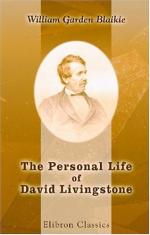Farther on they passed through an immense uninhabited tract, that had once evidently had a vast population. Then, in the Waiyau country, west of Mataka’s, came a splendid district 3400 feet above the sea, as well adapted for a settlement as Magomero, but it had taken them four months to get at it, while Magomero was reached in three weeks. The abandonment of that mission he would never cease to regret. As they neared Lake Nyassa, slave parties became more common. On the 8th August, 1866, they reached the lake, which seemed to Livingstone like an old familiar friend which he never expected to see again. He thanked God, bathed again in the delicious water, and felt quite exhilarated.
Writing to his son Thomas, 28th August, he says:
“The Sepoys were morally unfit for travel, and then we had hard lines, all of us. Food was not to be had for love or money. Our finest cloths only brought miserable morsels of the common grain. I trudged it the whole way, and having no animal food save what turtle-doves and guinea-fowls we occasionally shot, I became like one of Pharaoh’s lean kine. The last tramp [to Nyassa] brought us to a land of plenty. It was over a very fine country, but quite depopulated.... The principal chief, named Mataka, lives on the watershed overhanging this, but fifty miles or more distant from this; his town contained a thousand houses—many of them square, in imitation of the Arabs. Large patches of English peas in full bearing grew in the moist hollows, or were irrigated. Cattle showed that no tsetse existed. When we arrived, Mataka was just sending back a number of cattle and captives to their own homes. They had been taken by his people without his knowledge from Nyassa. I saw them by accident: there were fifty-four women and children, about a dozen young men and boys, and about twenty-five or thirty head of cattle. As the act was spontaneous, it was the more gratifying to witness....
“I sometimes remember you with some anxiety, as not knowing what opening may be made for you in life.... Whatever you feel yourself best fitted for, ’commit thy way to the Lord, trust also in Him, and He will bring it to pass.’ One ought to endeavor to devote the peculiarities of his nature to his Redeemer’s service, whatever these may be.”
Resting at the lake, and working up journal, lunars, and altitudes, he hears of the arrival of an Englishman at Mataka’s, with cattle for him, “who had two eyes behind as well as two in front—news enough for awhile.” Zoology, botany, and geology engage his attention as usual. He tries to get across the lake, but cannot, as the slavers own all the dhows, and will neither lend nor sell to him; he has therefore to creep on foot round its southern end. Marks of destruction and desolation again shock the eye—skulls and bones everywhere. At the point where the Shire leaves Nyassa, he could not but think of disappointed hopes—the




